The AMD Zen and Ryzen 7 Review: A Deep Dive on 1800X, 1700X and 1700
by Ian Cutress on March 2, 2017 9:00 AM ESTConclusion
The march towards Ryzen has been a long road for AMD. Anyone creating a new CPU microarchitecture deserves credit as designing such a complex thing requires millions of hours of hard graft. Nonetheless, hard graft doesn’t always guarantee success, and AMD’s targets of low power, small area, and high-performance while using x86 instructions was a spectacularly high bar, especially with a large blue incumbent that regularly outspends them in R&D many times over.
Through the initial disclosures on the Zen microarchitecture, one thing was clear when speaking to the senior staff, such as Dr. Lisa Su, Mark Papermaster, Jim Anderson, Mike Clark, Sam Naffziger and others: that quiet confidence an engineer gets when they know their product is not only good but competitive. The PR campaign up until this point of launch has been managed (we assume) such that the trickle of information comes down the pipe and keeps people on the edge of their seat. Given the interest in Ryzen, it has worked.
Ryzen is AMD’s first foray into CPUs on 14nm, and using FinFETs, as well as a new microarchitecture and pulling in optimization methods from previous products such as Excavator/Carrizo and the GPU line. If we were talking tick-tock strategy, such as Intel’s process over the last decade, this is both a tick and a tock in one. Ryzen is the first part of that strategy, on the desktop processors first, with server parts coming out in Q2 and Notebook APUs in 2H17. One of the main concerns with AMD is typically the ability to execute – get enough good parts out on time and with sufficient performance to merit their launch. As Dr. Su said in our interview, it’s one big hurdle but there are many to come.
| AMD Ryzen 7 SKUs | ||||||
| Cores/ Threads |
Base/ Turbo |
L3 | TDP | Cost | Launch Date | |
| Ryzen 7 1800X | 8/16 | 3.6/4.0 | 16 MB | 95 W | $499 | 3/2/2017 |
| Ryzen 7 1700X | 8/16 | 3.4/3.8 | 16 MB | 95 W | $399 | 3/2/2017 |
| Ryzen 7 1700 | 8/16 | 3.0/3.7 | 16 MB | 65 W | $329 | 3/2/2017 |
Today’s launch of three CPUs, part of the Ryzen 7 family, will be followed by Ryzen 5 in Q2 and Ryzen 3 later in the year. Ryzen 7 uses a single eight-core die, and uses simultaneous multi-threading (SMT) to provide sixteen threads altogether, up to 4.0 GHz on the top Ryzen 7 1800X chip for $499. Officially AMD is positioning the 1800X as a direct competitor to Intel’s i7-6900K, an 8-core processor with hyperthreading that costs over $1000. In our benchmarks, it’s been clear that this battle goes toe-to-toe.
Analyzing the Results
In the brief time we had before getting a sample and this review, we were able to run our new benchmark suite on twelve different Intel CPUs, as well as AMD’s former APU crown holder, the A10-7890K. Throughout the discussion about Ryzen, AMD was advertising a 40%+ gain in raw performance per clock over their previous generations, which was then upped to 52% when the CPUs were actually announced. Back of the envelope calculations put Ryzen at the level of the high-end desktop Broadwell CPUs or just about, which means it would be a case of pure frequency. That being said, Intel is already running CPUs two generations ahead on its mainstream platform, such as the Kaby-Lake based i7-7700K, so it’s going to be an interesting analysis.
Multi-Threaded Tests
First up, AMD’s strength in our testing was clearly in the multithreaded benchmarks. Given the microarchitectures of AMD’s and Intel’s high-performance x86 cores are somewhat similar, for the most part there’s a similar performance window. Intel’s design is slightly wider and has a more integrated cache hierarchy, meaning it manages to win out on ‘edge cases’ that might be a result of bad code. As one might expect, it takes a lot of R&D to cater for particular edge cases.
But as a workstation-based core design, the Zen microarchitecture pulls no punches. As long as the software doesn’t need strenuous AVX code, and manages its memory carefully (such as false sharing), the performance of Ryzen in conventional multi-threaded CPU environments means AMD is back in the game. This is going to be beneficial for the Zen microarchitecture when we see it applied into server environments, especially those that require virtualization.
Single Threaded Tests
Since the launch of Bulldozer, AMD has always been a step behind on single-threaded performance. ST performance is a holy-grail of x86 core design, but often requires significantly advanced features that can potentially burn extra power to get there. AMD’s message on this, even in our interview with Dr. Su, is that AMD has the ability to innovate. This is why AMD promotes features such as SenseMI for their new advanced pre-fetch algorithms, why implementing a micro-op cache into the core was a big thing, and how having double the L2 cache over Intel’s comparable parts were important to the story. Nonetheless, AMD hammered down that a 40%+ IPC gain into its narrative, which then folded into a 52% gain at launch. We’ll take a deeper look into this in a separate review, but our single threaded results show that AMD is back in the fight.
Most of the data points in this graph come from Intel Kaby Lake processors at various frequencies, but the important thing here is that the Ryzen parts are at least in the mix, sitting above the other eight core parts on the far right of the graph. Also, the jump from the A10 up to the 1700 is a big generational jump, let alone considering the 1800X.
Overall Performance
Putting these two elements into the same graph gives the following:
By this measure, for overall performance, it’s clear the Core i7-7700K is still better in price/performance. However, AMD would argue that the competition for the Ryzen 7 parts is on the right, with the i7-6900K and i7-5960X. In our CPU-based results, AMD wins this performance per dollar hands down.
Some Caveats
Since testing this review, and waiting a few days to even write the conclusion, there has been much going on about ways in which AMD’s performance is perhaps being neutered. This list includes discussions around:
- Windows 10 RTC disliking 0.25x multipliers, causing timing issues,
- Software not reading L3 properly (thinking each core has 8MB of L3, rather than 2MB/core),
- Latency within a CCX being regular, but across CCX boundaries having limited bandwidth,
- Static partitioning methods being used shows performance gains when SMT is disabled,
- Ryzen showing performance gains with faster memory, more so than expected,
- Gaming Performance, particularly towards 240 Hz gaming, is being questioned,
- Microsoft’s scheduler not understanding the different CCX core-to-core latencies,
- Windows not scheduling threads within a CCX before moving onto the next CCX,
- Some motherboards having difficulty with DRAM compatibility,
- Performance related EFIs being highly regularly near weekly since two weeks before launch.
A number of these we are already taking steps to measure. Some of the fixes to these issues come from Microsoft’s corner, and we are already told that both AMD and Microsoft are underway to implement scheduling routines to fix these. Other elements will be AMD focused: working with software companies to ensure that after a decade of programming for the other main x86 microarchitecture, it’s a small step to also consider the Zen platform.
At this point, we’re unsure at what level some of these might be default design issues with Zen. The issue of single-thread performance increasing when SMT is disabled (we’ve done some pre-testing, up to 6% in ST) is clearly related to the design of the core, with static partitioning vs competitive partitioning of certain parts of the design. The CCX latency and detection is one that certainly needs further investigation.
The future according to Senior Fellow Mike Clark, one of the principle engineers on the Zen microarchitecture, is that AMD knows where the easy gains are for their next generation product (codenamed Zen 2), and they're already working through the list. A question is then if Intel continues at 5% performance gains clock for clock each year, can AMD make 5-15% and close the gap?
The Silver Lining
It is relevant to point out that Intel is on its 7th Generation of Core microarchitecture. Sure, it looks significantly different when it was designed, but software vendors have had seven generations to optimize for it. Coming in and breaking the incumbent’s stranglehold is difficult, when every software vendor knows that design in and out. While AMD’s design looks similar to Intel, there are nuances which programmers might not have expected, and so it might be a good couple of years before the programming guides have made their way through into production software.
But,
When we look at the CPU benchmarks as part of this review, which have a strong range in algorithm difficulty and dependency, AMD still does well. There’s no getting around that AMD has a strong workstation core design on their hands. This bodes well for users who need compute at a lower cost, especially when you can pick up an eight-core Ryzen 7 at half the cost of the competition.
This makes the server story for AMD, under Naples, much more interesting.
AnandTech Recommended Award
For Performance/Price on a Workstation CPU


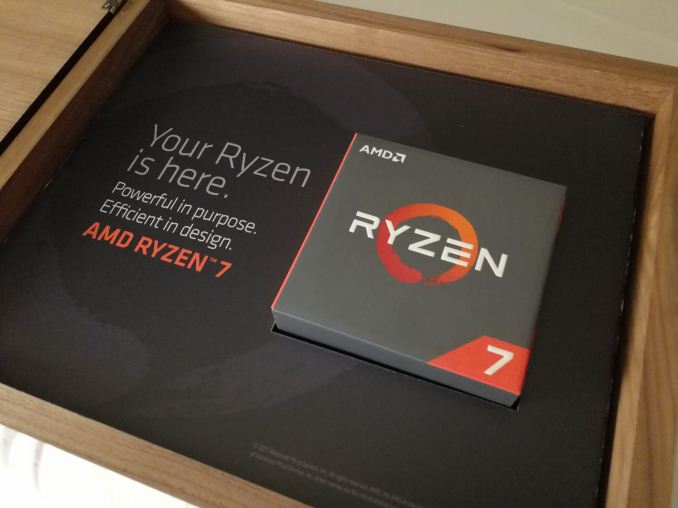
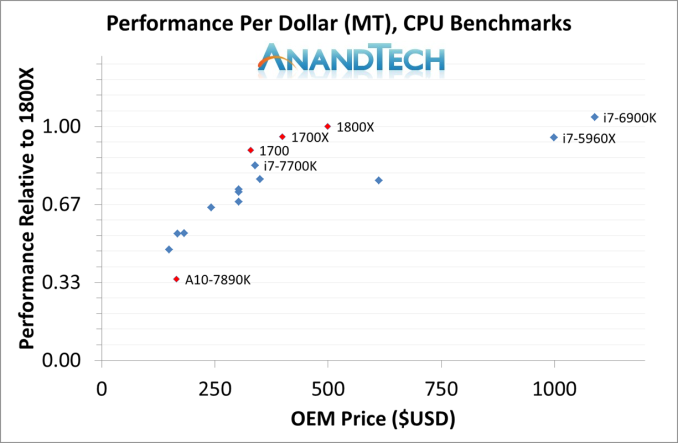
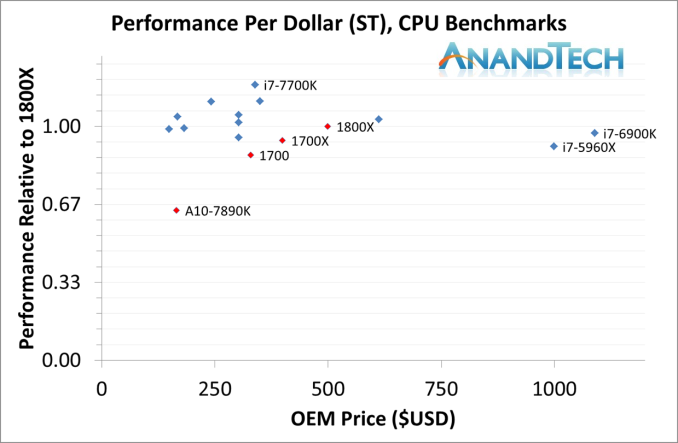
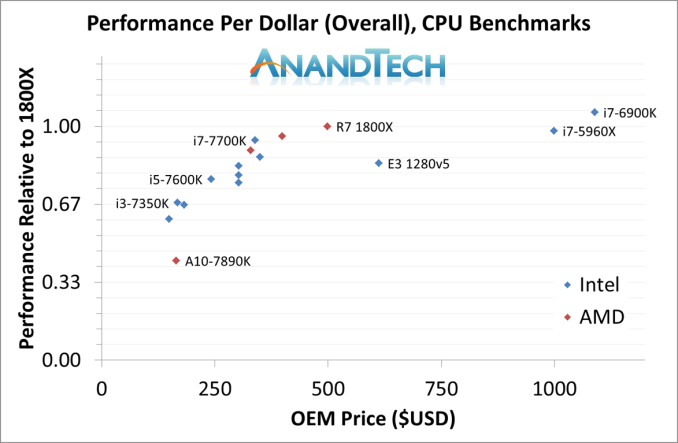
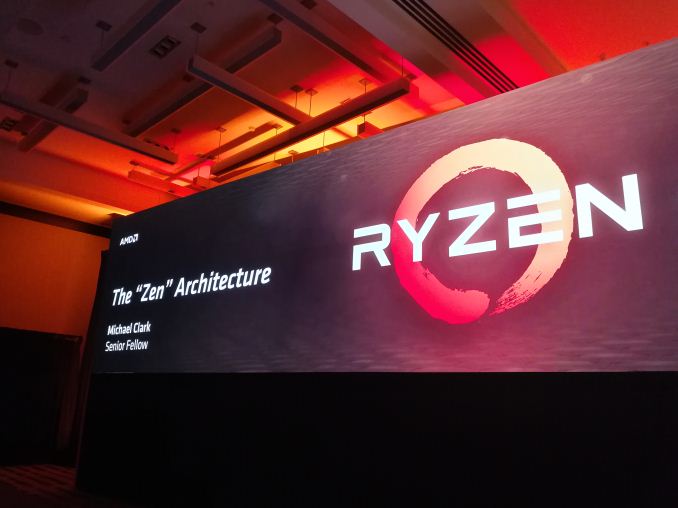










574 Comments
View All Comments
lakerssuperman - Thursday, March 2, 2017 - link
People like me. I was previously running a 2600k overclocked. Nice chip. Still runs great, but I was looking for an upgrade about a year ago as one of the things I do a lot of is Handbrake conversion for my HTPC. Going to even the newest Intel 4 core got me maybe 20% improvement on one of my major workloads for insane amounts of money and going to the high end to get 8-10 cores was just not justifiable.I ended up buying a used Xeon/X79 motherboard combo for around $300 off ebay. 8 cores/16 threads and it works great for Handbrake. I lost some clock speed in the move so single thread performance took a bit of a hit, but was more than made up for in multi-thread performance. I can still game on this CPU just fine and I don't play the newest stuff right away anyway just because of time constraints.
The X79 platform is fine for what I'm doing with it. Would I like the new stuff? Sure. And if I was in the position I was last year looking for an upgrade I don't see how I wouldn't get an 1800x. It gives me the right balance of features for what I do with my computer.
If I was just gaming, I'd look at Intel currently because their 4 core i5 is the sweet spot for this. But I'm not just gaming so this chip is infinitely more attractive to someone like me. With the price and features I can't see how it isn't a winner and when the 4 and 6 core parts come out at likely higher frequencies, I think they are going to be the real winners for gaming.
rarson - Thursday, March 2, 2017 - link
Ryzen is clearly well-suited to anyone who values high performance in a multitude of usage scenarios over one single usage scenario, especially if one cares about how much money they need to spend to achieve those results.injurer - Friday, March 3, 2017 - link
1800X is definitely designed for enthusiast, and AMD fans, but when you go to 1700X this is a price killer targeting the mainstream. 1700 is on the same boat but at even lower price. All the 3 are 8 core chips and are quite close to the 6900K but at 2-4 times lower price.At the end I really believe AMD are still having to show us the real potential of their architecture. Those chips are just the start. Remember Ryzen design is a new from its core, so they definitely have room to ecpand and enhance it.
bill.rookard - Thursday, March 2, 2017 - link
Well, thing to remember is that for those looking for a new build, they now have a legitimate choice. I still do see in the future that things will only go more multithreaded, and even though the i7-7700k is still a great chip, having more physical cores and resources to throw at it will only help.To that end, again, anyone planning a NEW build from the ground up will be able to seriously consider a Ryzen system.
Worst case, think about it. In the deep dive they had mention of 'competitive resource sharing' with SMT enabled. If you were to disable SMT on Ryzen - it would give you 8 PHYSICAL cores versus the 4 physical/4 logical cores of the 7700k. Without those resources being partially used across 16 threads - all resources would be allocated to the physical cores instead, potentially allowing more processing power per physical core.
There's still quite a bit to be checked out and dug through.
lilmoe - Thursday, March 2, 2017 - link
This. I want 2 things dug deeper in follow ups:1) Single/multi threaded performance with SMT disabled VS SMT enabled.
2) Game comparisons with more sensible GPUs (which actually ship and sell in volume, IE: the ones people actually buy), like the GTX 1060 and/or RX 480.
BurntMyBacon - Friday, March 3, 2017 - link
@lilmoeI agree with 1). Intel had HT for several generations before it was universally better to leave it enabled (still needs to be disabled some times, but these are more the edge cases now).
Not so sure I'm onboard with 2). Pairing a $200 GPU with a $500 processor for gaming purposes seems a little backwards. I'd like to see that (GTX1060 / RX480) gaming comparison on a higher clocked R5 or R3 processor when they are released.
Meteor2 - Friday, March 3, 2017 - link
I'd rather see tests paired with a 1080 Ti. At RX480/1060 level, it's well known the bottleneck is GPU performance not CPU. A 1080 Ti should be fast enough to show up the CPU.lilmoe - Friday, March 3, 2017 - link
@BurntMyBacon @Meteor2Lots of people, like me, are more into CPU power. I'm OK with a mid-range GPU. Gaming is not my top priority, and when I do, It's never above 1080p.
It'd be interesting to see if there are differences. I wouldn't dismiss it, saying the GPU would be the bottleneck so fast.
bigboxes - Sunday, March 5, 2017 - link
I'm with you on that. Gaming is way down in my priority list. I do it occasionally just because I love to see what my hardware can do. I currently have a ultrawide 1080p monitor. When I move to 4K then hopefully midrange GPU will cover that. My CPU is a 4790K. It's great for most tasks. I've been wanting to go to 6/8 core for some time, but the cost for the platform was too high. I think in a couple of years I will seriously think about Ryzen when building a new workstation.rarson - Thursday, March 2, 2017 - link
I am interested in seeing potential improvement due to BIOS updates. Additionally, I'm interested in seeing potential improvement due to better multi-threaded software. My hunch is that AMD is either on-par or better than Intel, or maybe damn near that prediction, so I think the 4-core parts will compare well to the current Skylake SKUs. I also expect them to overclock better than the 8-core chips. I guess we'll just have to wait for them to release.8 physical cores is definitely better than 4 cores with SMT/HTT/whatever you want to call it.